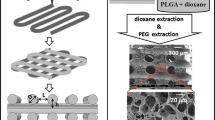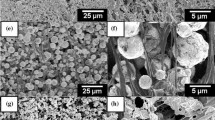Abstract
Porous structures destined for tissue engineering applications should ideally show controlled and narrow pore size distributions with fully interconnected pores. This study focuses on the development of novel poly(ε-caprolactone) (PCL) structures with fully connected pores of 84, 116, 141, and 162 μm average diameter, from melt blending of PCL with poly(ethylene oxide) (PEO) at the co-continuous composition, followed by static annealing and selective extraction of PEO. Our results demonstrate a low onset concentration for PEO continuity and a broad region of phase inversion. A novel in vitro assay was used to compare scaffold infiltration by 10-μm diameter polystyrene beads intended to mimic trypsinized human bone marrow stromal cells (hBMSCs). Beads showed a linear increase in the extent of scaffold infiltration with increasing pore size, whereas BMSCs infiltrated 162 and 141 μm pores, below which the cells aggregated and adhered near the seeding area with low infiltration into the porous device. While providing a baseline for non-aggregated systems, the beads closely mimic trypsinized cells at pore sizes equal to or larger than 141 μm, where optimal retention and distribution of hBMSCs are detected. A cytotoxicity assay using L929 cells showed that these scaffolds were cytocompatible and no cell necrosis was detected. This study shows that a melt blending approach produces porous PCL scaffolds of highly controlled pore size, narrow size distribution and complete interconnectivity, while the bead model system reveals the baseline potential for a homogeneous, non-aggregated distribution of hBMSCs at all penetration depths.








Similar content being viewed by others
References
Langer R, Vacanti JP. Tissue engineering. Science. 1993;260(5110):920–6. doi:10.1126/science.8493529.
Hutmacher DW. Scaffolds in tissue engineering bone and cartilage. Biomaterials. 2000;21(24):2529–43. doi:10.1016/s0142-9612(00)00121-6.
Yoon DM, Fisher JP. Polymeric scaffolds for tissue engineering applications. In: Bronzino JD, editor. Tissue engineering and artificial organs. CRC Press; 2006. p. 37-1–37-18. doi:10.1201/9781420003871.ch37.
Santis RD, Catauro M, Silvio LD, Manto L, Raucci MG, Ambrosio L, et al. Effects of polymer amount and processing conditions on the in vitro behaviour of hybrid titanium dioxide/polycaprolactone composites. Biomaterials. 2007;28(18):2801–9. doi:10.1016/j.biomaterials.2007.02.014.
Gloria A, Russo T, D’Amora U, Zeppetelli S, D’Alessandro T, Sandri M, et al. Magnetic poly(epsilon-caprolactone)/iron-doped hydroxyapatite nanocomposite substrates for advanced bone tissue engineering. J R Soc Interface. 2013;10(80):20120833. doi:10.1098/rsif.2012.0833.
Chang HI, Perrie Y, Coombes AGA. Delivery of the antibiotic gentamicin sulphate from precipitation cast matrices of polycaprolactone. J Control Release. 2006;110(2):414–21. doi:10.1016/j.jconrel.2005.10.028.
Li W-J, Tuli R, Okafor C, Derfoul A, Danielson KG, Hall DJ, et al. A three-dimensional nanofibrous scaffold for cartilage tissue engineering using human mesenchymal stem cells. Biomaterials. 2005;26(6):599–609. doi:10.1016/j.biomaterials.2004.03.005.
Franco RA, Nguyen TH, Lee BT. Preparation and characterization of electrospun PCL/PLGA membranes and chitosan/gelatin hydrogels for skin bioengineering applications. J Mater Sci Mater Med. 2011;22(10):2207–18. doi:10.1007/s10856-011-4402-8.
Ng KW, Hutmacher DW, Schantz JT, Ng CS, Too HP, Lim TC, et al. Evaluation of ultra-thin poly(epsilon-caprolactone) films for tissue-engineered skin. Tissue Eng. 2001;7(4):441–55. doi:10.1089/10763270152436490.
Borriello A, Guarino V, Schiavo L, Alvarez-Perez MA, Ambrosio L. Optimizing PANi doped electroactive substrates as patches for the regeneration of cardiac muscle. J Mater Sci Mater Med. 2011;22(4):1053–62. doi:10.1007/s10856-011-4259-x.
Causa F, Netti PA, Ambrosio L, Ciapetti G, Baldini N, Pagani S, et al. Poly-ε-caprolactone/hydroxyapatite composites for bone regeneration: in vitro characterization and human osteoblast response. J Biomed Mater Res Part A. 2006;76A(1):151–62. doi:10.1002/jbm.a.30528.
Ghasemi-Mobarakeh L, Semnani D, Morshed M. A novel method for porosity measurement of various surface layers of nanofibers mat using image analysis for tissue engineering applications. J Appl Polym Sci. 2007;106(4):2536–42. doi:10.1002/app.26949.
Dalton PD, Woodfield T, Hutmacher WD. SnapShot: polymer scaff olds for tissue engineering. Biomaterials. 2009;30(4):701–2. doi:10.1016/S0142-9612(08)00900-9.
Karageorgiou V, Kaplan D. Porosity of 3D biomaterial scaffolds and osteogenesis. Biomaterials. 2005;26(27):5474–91. doi:10.1016/j.biomaterials.2005.02.002.
Willemse RC, Posthuma de Boer A, van Dam J, Gotsis AD. Co-continuous morphologies in polymer blends: the influence of the interfacial tension. Polymer. 1999;40(4):827–34. doi:10.1016/S0032-3861(98)00307-3.
Sarazin P, Favis BD. Morphology control in co-continuous Poly(l-lactide)/polystyrene blends: a route towards highly structured and interconnected porosity in poly(l-lactide) materials. Biomacromolecules. 2003;4(6):1669–79. doi:10.1021/bm030034+.
Yuan Z, Favis BD. Coarsening of immiscible co-continuous blends during quiescent annealing. AIChE J. 2005;51(1):271–80. doi:10.1002/aic.10281.
Sarazin P, Roy X, Favis BD. Controlled preparation and properties of porous poly(l-lactide) obtained from a co-continuous blend of two biodegradable polymers. Biomaterials. 2004;25(28):5965–78. doi:10.1016/j.biomaterials.2004.01.065.
Gloria A, Causa F, Russo T, Battista E, Della Moglie R, Zeppetelli S, et al. Three-dimensional poly(epsilon-caprolactone) bioactive scaffolds with controlled structural and surface properties. Biomacromolecules. 2012;13(11):3510–21. doi:10.1021/bm300818y.
Dalton PD, Woodfield T, Hutmacher DW. Erratum to: SnapShot: polymer scaffolds for tissue engineering [Biomaterials 30/4 (2009) 701–702]. Biomaterials. 2009;30(12):2420. doi:10.1016/j.biomaterials.2009.01.049.
Yuan Z, Favis BD. Influence of the efficacy of interfacial modification on the coarsening of cocontinuous PS/HDPE blends during quiescent annealing. J Polym Sci Part B Polym Phys. 2006;44(4):711–21. doi:10.1002/polb.20733.
Yuan Z, Favis BD. Macroporous poly(l-lactide) of controlled pore size derived from the annealing of co-continuous polystyrene/poly(l-lactide) blends. Biomaterials. 2004;25(11):2161–70. doi:10.1016/j.biomaterials.2003.08.060.
Anderson KE, Stevenson BR, Rogers JA. Folic acid–PEO-labeled liposomes to improve gastrointestinal absorption of encapsulated agents. J Control Release. 1999;60(2–3):189–98. doi:10.1016/s0168-3659(99)00072-3.
Suh H, Jeong B, Rathi R, Kim SW. Regulation of smooth muscle cell proliferation using paclitaxel-loaded poly(ethylene oxide)–poly(lactide/glycolide) nanospheres. J Biomed Mater Res. 1998;42(2):331–8. doi:10.1002/(sici)1097-4636(199811)42:2<331:aid-jbm19>3.0.co;2-l.
Park S-J, Kim K-S, Kim S-H. Effect of poly(ethylene oxide) on the release behaviors of poly(ε-caprolactone) microcapsules containing erythromycin. Colloids Surf B. 2005;43(3–4):238–44. doi:10.1016/j.colsurfb.2005.04.010.
Washburn NR, Simon CG, Tona A, Elgendy HM, Karim A, Amis EJ. Co-extrusion of biocompatible polymers for scaffolds with co-continuous morphology. J Biomed Mater Res. 2002;60(1):20–9. doi:10.1002/jbm.10049.
Carreau PJ, De Kee D, Chhabra RP. Rheology of polymeric systems: principles and applications. Cincinnati: Hanser Publishers; Munich, New York: Hanser/Gardner Publications; 1997.
Washburn EW. The dynamics of capillary flow. Phys Rev. 1921;17(3):273–83.
Tessmar JKV, Holland TA, Mikos AG. Salt leaching for polymer scaffolds. In: Scaffolding in tissue engineering. CRC Press; 2005. p. 111–24. doi:10.1201/9781420027563.pt2.
Kim G, Park J, Park S. Surface-treated and multilayered poly(ε-caprolactone) nanofiber webs exhibiting enhanced hydrophilicity. J Polym Sci Part B Polym Phys. 2007;45(15):2038–45. doi:10.1002/polb.21211.
Hulbert SF, Young FA, Mathews RS, Klawitter JJ, Talbert CD, Stelling FH. Potential of ceramic materials as permanently implantable skeletal prostheses. J Biomed Mater Res. 1970;4(3):433–56. doi:10.1002/jbm.820040309.
Mattanavee W, Suwantong O, Puthong S, Bunaprasert T, Hoven VP, Supaphol P. Immobilization of biomolecules on the surface of electrospun polycaprolactone fibrous scaffolds for tissue engineering. ACS Appl Mater Interfaces. 2009;1(5):1076–85. doi:10.1021/am900048t.
Sudarmadji N, Tan JY, Leong KF, Chua CK, Loh YT. Investigation of the mechanical properties and porosity relationships in selective laser-sintered polyhedral for functionally graded scaffolds. Acta Biomater. 2011;7(2):530–7. doi:10.1016/j.actbio.2010.09.024.
Acknowledgments
The authors would like to thank Sylvie St-Amour and Sylvie Sauriol at FPInnovations for their valuable assistance with the porosimetric measurements and Guillaume Lessard at École Polytechnique de Montréal for his help in the preparation of the scaffolds. Also, financial support of the Natural Sciences and Engineering Research Council of Canada (NSERC) through its Network for Innovative Plastic Materials and Manufacturing Processes (NIPMMP), NSERC Discovery (to CDH), and salary support for XL and CDH from the Fonds de Recherche en Santé du Québec (FRQ-S, Bourse de Carrière Nationale to CDH) and the Mentor program for MBA is gratefully acknowledged.
Author information
Authors and Affiliations
Corresponding author
Rights and permissions
About this article
Cite this article
Ghavidel Mehr, N., Li, X., Ariganello, M.B. et al. Poly(ε-caprolactone) scaffolds of highly controlled porosity and interconnectivity derived from co-continuous polymer blends: model bead and cell infiltration behavior. J Mater Sci: Mater Med 25, 2083–2093 (2014). https://doi.org/10.1007/s10856-014-5256-7
Received:
Accepted:
Published:
Issue Date:
DOI: https://doi.org/10.1007/s10856-014-5256-7




